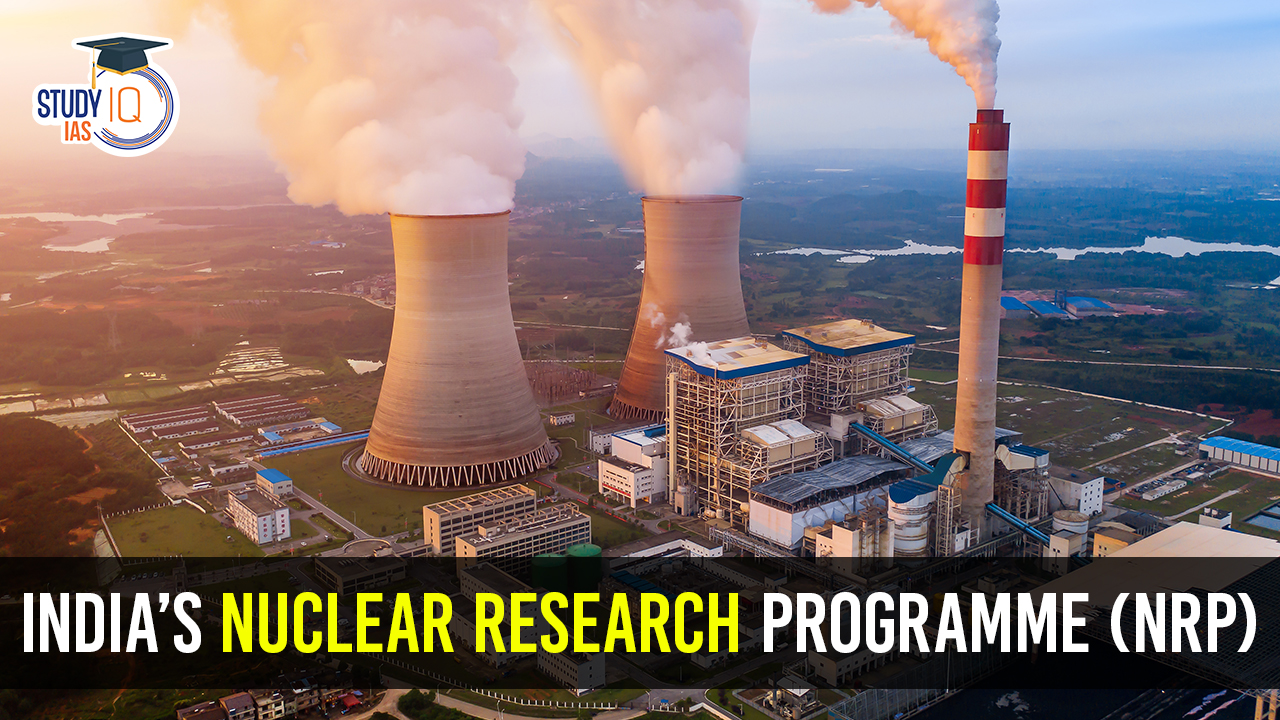Table of Contents
India’s Nuclear Research Programme (NRP) was conceived shortly after gaining independence to address both the security and energy needs of the newly sovereign nation. Given India’s limited uranium reserves and abundant thorium deposits, the program was designed to ensure energy self-reliance. This innovative approach aimed to harness the vast thorium reserves, securing India’s independence in the energy sector.
We’re now on WhatsApp. Click to Join
India’s Three-Stage Nuclear Research Programme (NRP)
India’s Nuclear Research Programme (NRP), devised by physicist Homi Bhabha in the 1950s, aims to secure long-term energy independence by utilizing the country’s uranium and abundant thorium reserves. With just 1-2% of global uranium reserves but 25% of the world’s thorium reserves, India’s focus on thorium is crucial. However, thorium’s complexity and low uranium prices have posed challenges. India’s continued import of uranium and delays in the Prototype Fast Breeder Reactor’s commissioning are issues. The 2005 Indo-US Nuclear Deal and NSG waiver have offered new opportunities for this ambitious program, estimated to provide 500 GWe for centuries. Here’s an in-depth look at each stage and the rationale behind this innovative energy plan:
Stage 1: Natural Uranium Heavy Water Reactors
In the first stage, the program begins with the use of natural uranium-fueled heavy-water reactors. These reactors employ heavy water (deuterium oxide) as a moderator and coolant. This initial phase is crucial for initiating the atomic power program. However, natural uranium is not an ideal fuel for sustained nuclear energy production because it doesn’t efficiently sustain a chain reaction. The main goal of this stage is to kickstart the nuclear energy program.
Stage 2: Plutonium-Fueled Fast Breeder Reactors
The second stage of the program introduces fast breeder reactors that use plutonium as a fuel. Fast-breeder reactors are capable of producing more fissile material (plutonium-239) than they consume. These reactors serve a dual purpose. They generate electricity for India’s growing energy demands while also producing plutonium. The produced plutonium can be used in a second generation of power stations designed to convert thorium into uranium-233 or depleted uranium into additional plutonium. This stage is an essential intermediary step for the program’s ultimate goal.
Stage 3: Thermal Breeder Reactors
The third and final stage revolves around thermal breeder reactors. These reactors are designed to maximize the utilization of India’s vast thorium reserves. Thorium, while not fissile itself, can be transmuted into fissile uranium-233 when exposed to neutrons. Thermal breeder reactors facilitate this conversion, enabling sustained nuclear fission and energy production. What’s unique about these reactors is that they produce more fissile material (Uranium-233) than they consume, making them self-sustaining. This stage represents the long-term vision of India’s nuclear power program.
Rationale for India’s Nuclear Research Programme (NRP)
Homi Bhabha provided a compelling rationale for this three-stage approach. India possesses a vast quantity of thorium, estimated at over 500,000 tons, in readily extractable form, while its known uranium reserves are substantially limited. The primary objective of this program is to shift the focus of nuclear power generation from uranium to thorium as quickly as possible. Bhabha emphasized that the initial generation of atomic power stations, based on natural uranium, is only a starting point. The plutonium produced in this stage is crucial for the second generation of power stations, which is an intermediate step for the ultimate goal of the third generation of breeder reactors.
In November 1954, Homi Bhabha presented this three-stage plan for national development at the “Development of Atomic Energy for Peaceful Purposes” conference, attended by India’s first Prime Minister, Jawaharlal Nehru. Four years later, in 1958, the Indian government officially adopted this strategic plan. The program has aimed to harness India’s unique energy resource base to ensure long-term energy security and self-reliance.
Recognizing the potential of thorium as a sustainable and abundant source of power, India’s Three-Stage Nuclear Power Program reflects a visionary approach to meeting the country’s energy needs while minimizing reliance on uranium and establishing a resilient, self-sustaining energy infrastructure.
Objectives India’s Nuclear Research Programme (NRP)
- India has only 2% of the world’s uranium reserves but possesses a significant 25% of the global thorium reserves.
- Exclusion from certain international nuclear treaties restricted India’s participation in global nuclear trade.
- India, with its large population and growing economy, heavily depended on coal and crude oil imports to meet its energy demands.
- To achieve energy self-sufficiency and cater to its increasing population and expanding economy, India developed the Three-Stage Nuclear Power Program.
India’s Nuclear Research Programme (NRP) Importance
India’s Nuclear Research Programme (NRP) is of significant importance:
- Energy Security: NRP plays a pivotal role in securing India’s energy needs by harnessing nuclear power, particularly essential given the country’s energy demand.
- National Defense: India’s nuclear program ensures a credible deterrent against external threats, safeguarding national security.
- Thorium Utilization: NRP focuses on thorium-based nuclear technology, capitalizing on India’s substantial thorium reserves, reducing dependence on uranium.
- Scientific Advancements: The program drives scientific research and innovation, positioning India as a global leader in nuclear science.
- Diplomatic Impact: NRP influences India’s foreign policy and diplomatic relations, enabling participation in international nuclear agreements.
- Long-Term Sustainability: It offers a sustainable solution to India’s energy challenges, contributing to the nation’s economic growth and development.
India’s Nuclear Research Programme (NRP) Challenges
India’s Nuclear Research Programme (NRP) faces several challenges:
- Resource Constraints: Limited domestic uranium reserves necessitate heavy reliance on imports for nuclear fuel.
- Complexity of Thorium: Thorium-based technology presents technical challenges, requiring extensive research and development.
- Non-Proliferation Concerns: India’s nuclear ambitions have posed challenges in terms of non-proliferation agreements and international relations.
- Safety and Security: Ensuring the safety and security of nuclear facilities is crucial, given India’s population density.
- Infrastructure Development: Building and maintaining a robust nuclear infrastructure demands significant investments and resources.
- International Collaboration: NRP’s integration with the global nuclear community remains a challenge due to India’s unique nuclear status.
- Public Perception: Gaining public acceptance and addressing concerns about nuclear energy and safety is an ongoing challenge.
Way Forward for India’s Nuclear Research Programme (NRP)
- Enhanced Resource Exploration: Continue efforts to explore and develop uranium reserves, reducing reliance on imports.
- Research and Development: Invest in research to overcome technical challenges in thorium-based technology and improve reactor efficiency.
- Diplomacy and Collaboration: Strengthen diplomatic ties to facilitate international collaboration in the nuclear field, enhancing access to resources and expertise.
- Safety Measures: Prioritize stringent safety and security protocols for nuclear facilities, ensuring public and environmental safety.
- Infrastructure Investment: Allocate resources for the development and maintenance of a robust nuclear infrastructure, supporting long-term energy goals.
- Public Engagement: Implement public awareness and education initiatives to address concerns and build support for nuclear energy.
- Non-Proliferation Commitment: Uphold India’s commitment to non-proliferation agreements while leveraging its unique nuclear status for international cooperation.
- Sustainable Practices: Promote sustainable nuclear energy practices that align with India’s long-term energy and environmental objectives.
- Top of Form
India’s Nuclear Research Programme (NRP) UPSC
India’s Nuclear Research Programme (NRP) was initiated to address energy security and defense needs. It is characterized by the Three-Stage Nuclear Power Program, aiming to harness abundant thorium reserves. With only 2% of global uranium reserves but 25% of the world’s thorium, India has sought energy self-reliance. The program’s significance lies in securing energy, advancing science, and bolstering national defense. Challenges include resource constraints, technical complexities of thorium, safety, and the need for infrastructure development. To move forward, India should focus on resource exploration, R&D, diplomacy, safety, infrastructure investment, public engagement, non-proliferation, and sustainability.


 Genetically Modified Crops in India, Reg...
Genetically Modified Crops in India, Reg...
 What are Polycyclic Aromatic Hydrocarbon...
What are Polycyclic Aromatic Hydrocarbon...
 MALE Class Drones: Capabilities, Payload...
MALE Class Drones: Capabilities, Payload...





















